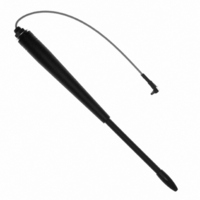0600-00025 Laird Technologies, 0600-00025 Datasheet - Page 15

0600-00025
Manufacturer Part Number
0600-00025
Description
ANTENNA 915MHZ 1/2WAVE 7" MMCX
Manufacturer
Laird Technologies
Datasheet
1.0600-00028.pdf
(48 pages)
Specifications of 0600-00025
Antenna Type
Whip: 1/2 Wave, Swivel, Tilt (Right Angle)
Number Of Bands
1
Frequency
902MHz ~ 928MHz
Vswr
2
Gain
2dBi
Termination
MMCX R/A Plug
Mounting Type
Chassis Mount
Height (max)
7.2" (182.99mm)
Impedance
50 Ohms
Technology Type
1/2 Wave Wireless Transceiver Antenna
Termination Style
MMCX
Lead Free Status / RoHS Status
Lead free / RoHS Compliant
Lead Free Status / RoHS Status
Lead free / RoHS Compliant, Lead free / RoHS Compliant
Flow Control
Flow control refers to the control of data flow between transceivers. It is the method used to handle data in the transmit/receive
buffer and determines how data flow between the transceivers is started and stopped. Often, one transceiver is capable of sending
data much faster than the other can receive and Flow control allows the slower device to tell the faster device when to pause and
resume data transmission.
When a transceiver has data to send, it sends a Ready To Send signal and waits for a Clear To Send response from the receiving
unit. If the receiving radio is ready to accept data it will assert its CTS low. These signals are sent apart from the data itself on
separate wires.
H
When Half Duplex communication is chosen, the AC4790 will send a packet out over the RF whenever it can. This can cause
packets sent by multiple transceivers at the same time to collide with each other over the RF. To prevent this, Full Duplex
communication can be chosen. Full Duplex shares the bandwidth intelligently to enable two-way collision-free communication by
calculating the amount of time until the next hop to ensure that it has time to send the packet. If there is enough time, it will send
the packet: if not, it will wait until its next appropriate hop. The radio which initiates the session transmits during the even hops
while the remaining radio(s) will transmit during the odd hops. Although the RF hardware is still technically half duplex, the
bandwidth sharing makes the transceiver seem full duplex. Enabling Full Duplex can cause overall throughputs to be cut in half.
ALF
CAN I IMPLEMENT A DESIGN USING JUST TXD, RXD AND GND (THREE-WIRE INTERFACE)?
Yes. However, it is strongly recommended that your hardware monitor the CTS pin of the radio. CTS is taken High by the
radio when its interface buffer is getting full. Your hardware should stop sending at this point to avoid a buffer overrun (and
subsequent loss of data).
You can perform a successful design without monitoring CTS. However, you need to take into account the amount of
latency the radio adds to the system, any additional latency caused by Transmit Retries or Broadcast Attempts, how often
you send data, non-delivery network timeouts and interface data rate. Polled type networks, where the Server host
requests data from the Client host and the Client host responds, are good candidates for avoiding the use of CTS. This is
because no one transceiver can monopolize the RF link. Asynchronous type networks, where any radio can send to
another radio at any point in time, are much more difficult to implement without the use of CTS.
Quick Tip:
D
UPLEX
/ F
ULL
D
UPLEX
Figure 3 - Hardware Flow Control
15




















